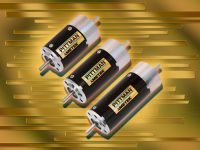www.powertransmission.com/articles/4088

Pittman 8540 Series Improves Power Density
January 18, 2012
Pittman 8540 Series brush-commutated DC motors are designed using the latest advancements in materials and manufacturing technology. This product line is suitable for customer applications requiring high performance in a small package size. The 8540 Series is a significant improvement over similar sized older generation Pittman motors and is perfect for high-tech applications found in medical devices, lab instrumentation, data storage, and precision automation machinery, to name a few. The most significant feature of the new design is a greatly improved power density through the use of bonded neodymium magnets. The 8540 has approximately twice the continuous torque rating, compared with the previous generation of motors. The 8540 Series motors are 1.18" (30 mm) in diameter and are available in three lengths; 2.114" (53.69 mm), 2.585" (65.66 mm), and 3.057" (77.65 mm). Depending on the model, they can achieve a continuous torque rating from 2.5 oz-in (0.018 Nm) to 8.3 oz-in (0.059 Nm) without the use of a heat sink. The 8540 Series motors are available with 8 standard windings ranging from 9.55V to 48V. Customized windings also can be designed to optimize performance for a specific application requirement. The motors have standard pre-loaded ball bearings, allowing high speeds, radial and axial shaft loading, and higher temperatures. A new bearing support system, a 7 slot armature, and improved manufacturing techniques allow more balanced armatures resulting in very low vibration and audible noise characteristics. At low speeds, the motors exhibit very low cogging as a result of a optimized magnetic circuit design. Low vibration and low cogging makes the 8540 Series suitable for position control in servo applications. Complementary products include gearboxes, encoders, and brakes. The motors have the capability of extensive customization including shaft configurations, leadwire assemblies, optional EMI/RFI filtering components, transmission components (shaft gears, pulleys, or sprockets) and a variety of brush materials (including standard graphite).
